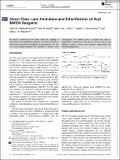Files in this item
Direct Chan–Lam amination and etherification of aryl BMIDA reagents
Item metadata
| dc.contributor.author | Halford-McGuff, John | |
| dc.contributor.author | Israel, Eva Marie | |
| dc.contributor.author | West, Matthew | |
| dc.contributor.author | Vantourout, Julien Christian | |
| dc.contributor.author | Watson, Allan J. B. | |
| dc.date.accessioned | 2022-12-05T10:30:02Z | |
| dc.date.available | 2022-12-05T10:30:02Z | |
| dc.date.issued | 2022-12-06 | |
| dc.identifier | 281975599 | |
| dc.identifier | 1b98124e-93f6-4cd4-8681-46c92b28b613 | |
| dc.identifier | 85143690854 | |
| dc.identifier | 000894491600008 | |
| dc.identifier.citation | Halford-McGuff , J , Israel , E M , West , M , Vantourout , J C & Watson , A J B 2022 , ' Direct Chan–Lam amination and etherification of aryl BMIDA reagents ' , European Journal of Organic Chemistry , vol. 2022 , no. 45 , e202200993 . https://doi.org/10.1002/ejoc.202200993 | en |
| dc.identifier.issn | 1434-193X | |
| dc.identifier.other | ORCID: /0000-0002-1582-4286/work/124490335 | |
| dc.identifier.uri | https://hdl.handle.net/10023/26541 | |
| dc.description | Funding: Engineering and Physical Sciences Research Council; University of St Andrews; Leverhulme Trust (GrantNumber(s): RF-2022-014). | en |
| dc.description.abstract | We report the development of a method for the direct Chan–Lam coupling of arylboronic acid N-methyliminodiacetic acid esters (ArBMIDA) with amine and alcohol nucleophiles. A wide range of C–N and C–O cross-coupled products in 34–99% yield (34 examples). This method serves to expand the scope of organoboron components that can be used directly in this oxidative coupling reaction and provides opportunities for streamlining synthesis. | |
| dc.format.extent | 4 | |
| dc.format.extent | 4725725 | |
| dc.language.iso | eng | |
| dc.relation.ispartof | European Journal of Organic Chemistry | en |
| dc.subject | Amination | en |
| dc.subject | Boron | en |
| dc.subject | Copper | en |
| dc.subject | Cross-coupling | en |
| dc.subject | Etherification | en |
| dc.subject | QD Chemistry | en |
| dc.subject | DAS | en |
| dc.subject | MCC | en |
| dc.subject.lcc | QD | en |
| dc.title | Direct Chan–Lam amination and etherification of aryl BMIDA reagents | en |
| dc.type | Journal article | en |
| dc.contributor.sponsor | The Leverhulme Trust | en |
| dc.contributor.sponsor | IBioIC | en |
| dc.contributor.institution | University of St Andrews. School of Chemistry | en |
| dc.contributor.institution | University of St Andrews. Sir James Mackenzie Institute for Early Diagnosis | en |
| dc.identifier.doi | https://doi.org/10.1002/ejoc.202200993 | |
| dc.description.status | Peer reviewed | en |
| dc.identifier.grantnumber | RF-2022-014 | en |
| dc.identifier.grantnumber | en |
This item appears in the following Collection(s)
Items in the St Andrews Research Repository are protected by copyright, with all rights reserved, unless otherwise indicated.

